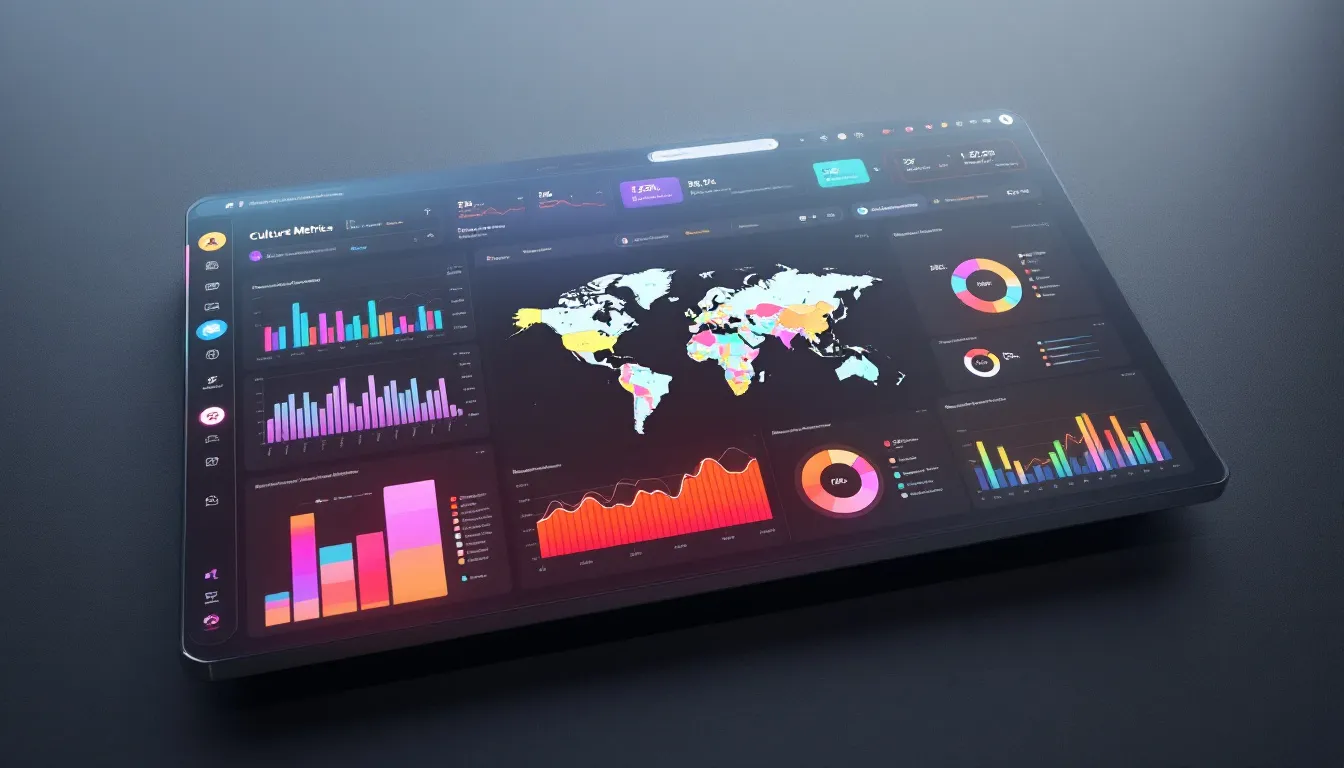When Satya Nadella became CEO of Microsoft in 2014, the company was struggling with a competitive, know-it-all culture that stifled innovation. Through a deliberate cultural transformation focused on growth mindset and collaboration, Microsoft’s market value increased from $300 billion to over $2 trillion. This dramatic turnaround illustrates a fundamental truth: company culture isn’t just about employee satisfaction—it’s a critical driver of business success.
In today’s competitive landscape, organizational culture has emerged as one of the most powerful differentiators between thriving companies and those that struggle to retain top talent and achieve their strategic goals. A survey of 1,800 global CEOs and CFOs revealed that 78% named culture among the top five factors for overall company value, while 92% said improving culture would increase company value.
This comprehensive guide will equip you with everything you need to understand, assess, and transform your workplace culture. You’ll discover the four essential pillars of strong company culture, learn a proven three-phase transformation strategy, and gain access to specific metrics and frameworks used by high-performance organizations to sustain cultural change over time.
What Is Company Culture and Why It Drives Business Success
Company culture encompasses the shared values, beliefs, behaviors, and practices that shape how employees experience their workplace every day. Think of it as your organization’s personality—the invisible force that influences how decisions are made, how people communicate, and how work gets done when no one is watching.
To define organizational culture more precisely, it manifests through multiple visible and invisible elements:
- Leadership decisions and management styles that demonstrate what’s truly valued
- Communication patterns including how information flows and feedback is given
- Office environment and workspace design that reflects company priorities
- Daily interactions and rituals that reinforce cultural norms
- Hiring practices and performance evaluations that shape who succeeds
- Response to failures and celebrations of wins that reveal core beliefs

The business case for investing in positive workplace culture is compelling. Companies with highly engaged employees—a direct result of strong culture—show 21% greater profitability and 59% lower turnover compared to organizations with disengaged workforces. When you consider that voluntary turnover due to poor culture costs U.S. businesses approximately $223 billion over five years, the financial impact becomes impossible to ignore.
Patagonia exemplifies how organizational culture drives business objectives. Their environmental activism isn’t just marketing—it’s deeply embedded in their culture through policies like allowing employees to leave work for environmental protests and donating 1% of sales to environmental causes. This authentic alignment between values and actions has created a workforce so engaged that Patagonia receives over 9,000 applications for every job opening.
Netflix demonstrates another approach with their “Freedom and Responsibility” culture. By giving employees significant autonomy while demanding high performance, they’ve created a high performance culture that consistently attracts top talent in the competitive tech industry. Their radical transparency practices, including sharing detailed performance expectations and eliminating traditional performance reviews, have become a benchmark for other organizations seeking cultural transformation.
The connection between culture and competitive advantage extends beyond employee metrics to customer satisfaction and market performance. Organizations with strong cultures report 40% higher customer retention rates and 2.3 times higher revenue growth compared to companies with weak cultures. This correlation exists because engaged employees deliver better customer experiences, driving the business success that every leader seeks.
Recognizing the Signs of Your Current Company Culture
Before embarking on any culture change efforts, you need a clear understanding of your organization’s current cultural reality. The gap between what leaders think their culture is and what employees actually experience often reveals the biggest opportunities for improvement.
Start your assessment by observing these key cultural indicators:
Communication Patterns:
- How information flows through the organization (top-down, lateral, or multi-directional)
- Whether employees feel safe expressing dissenting opinions or raising concerns
- The tone and frequency of leadership communication with entire organization
- How conflicts are addressed and resolved across team structures
Decision-Making Processes:
- Who gets involved in important decisions and how quickly they’re made
- Whether decisions align with stated core values or contradict them
- How much autonomy employees have within their roles
- The transparency around strategic goals and business objectives
Employee Behaviors:
- How people interact during meetings (collaborative vs. competitive)
- Whether team members help each other or operate in silos
- How employees respond to change initiatives and new processes
- The level of innovation and risk-taking that’s encouraged or discouraged

Several warning signs indicate a culture that needs immediate attention:
- High turnover rates exceeding 15% annually, particularly among high performers
- Low employee engagement scores below industry benchmarks (typically under 60%)
- Glassdoor ratings below 3.5 stars with consistent themes in negative reviews
- Low internal promotion rates suggesting limited employee development
- Excessive sick leave usage often indicating stress or employee disengagement
- Difficulty attracting top talent despite competitive compensation packages
The most revealing assessment comes from comparing your stated values—those posted on your website and in employee handbooks—with your lived values demonstrated through daily practices. For example, if “innovation” is a core value but employees are penalized for failed experiments, there’s a fundamental misalignment that undermines trust and engagement.
Use these specific metrics to establish your cultural baseline:
- Employee Net Promoter Score (eNPS): Measures how likely employees are to recommend your company as a place to work
- Internal promotion rate: Percentage of leadership positions filled by internal candidates
- Time-to-fill for open positions: How quickly you can attract qualified candidates
- Performance distribution: Whether high performers are concentrated in certain departments
- Exit interview themes: Common reasons why people leave your organization
Conducting focus groups with employees at different levels and departments provides qualitative insights that surveys might miss. These conversations often reveal the real culture—the unwritten rules about how things actually get done, what behaviors are rewarded, and what causes talented people to leave.
Remember that culture exists at multiple levels within your organization. A strong company culture at the executive level doesn’t guarantee the same experience for frontline employees. Department-specific assessments help identify pockets of excellence that can be scaled as well as problem areas that need targeted intervention.
The Four Pillars of Strong Company Culture
Building a thriving organizational culture requires attention to four interconnected pillars that work together to create an environment where people thrive and business objectives are achieved. These pillars provide the structural foundation for sustainable culture transformation.
Leadership Behavior and Accountability
Leadership behavior sets the tone for the entire organization, with managers influencing approximately 70% of employee engagement through their daily actions and decisions. The most critical factor isn’t what leaders say about culture, but how consistently they model the desired behaviors and hold themselves accountable to the same standards they expect from others.
Effective cultural leaders demonstrate values through concrete actions:
- Decision-making transparency: Explaining the reasoning behind important choices and how they align with core values
- Vulnerability and learning: Admitting mistakes and showing how failures contribute to growth
- Consistent reinforcement: Recognizing behaviors that exemplify cultural values and addressing those that don’t
- Investment in people: Dedicating time and resources to employee development and well-being
The accountability framework starts at the top with senior leaders participating in regular culture assessments and receiving feedback from their teams. Quarterly culture scorecards that track specific behavioral metrics—such as response time to employee concerns or participation in mentoring programs—create measurable accountability for culture leadership.
Wells Fargo’s sales culture scandal illustrates the devastating impact when leadership behavior contradicts stated values. Despite public commitments to integrity, the pressure for aggressive sales tactics created an environment where employees felt compelled to open fake accounts to meet unrealistic targets. This misalignment between espoused values and leadership behavior resulted in billions in fines and lasting reputational damage.
Clear Communication and Transparency
Communication strategies form the backbone of culture transmission, determining how effectively values and expectations spread throughout the organization. Two-way communication systems that encourage feedback and dialogue are essential for building trust and ensuring that culture change efforts resonate with employees.
Effective communication includes:
- Regular all-hands meetings where leadership shares strategic updates and answers employee questions
- Transparent decision-making processes that help employees understand how choices affect the organization
- Multiple feedback channels including surveys, suggestion systems, and open-door policies
- Consistent messaging that reinforces cultural themes across all communication platforms
Buffer has pioneered radical transparency by sharing salary formulas, revenue dashboards, and even board meeting notes with all employees. This level of openness creates trust and helps employees understand how their work contributes to business success. While not every organization needs Buffer’s level of transparency, the principle of sharing appropriate information helps employees feel connected to the organization’s mission and direction.
Establish these communication cadences for effective culture transmission:
- Weekly team check-ins focused on both work progress and team dynamics
- Monthly culture pulse surveys with short, targeted questions about employee sentiment
- Quarterly town halls addressing culture progress alongside business results
- Annual comprehensive culture assessments that inform strategic planning
The goal isn’t just to communicate more, but to create alignment between what’s said and what’s experienced. When communication is consistent and follows through on commitments, it builds the trust necessary for culture transformation.
Employee Empowerment and Growth
Creating a sense of belonging and providing opportunities for development directly impacts employee engagement and retention. Organizations that invest 5-7% of their payroll in employee development programs see significantly higher retention rates and internal promotion success.
Employee empowerment includes several key components:
Career Development Programs:
- Structured mentorship opportunities pairing experienced employees with high-potential team members
- Skills training initiatives that prepare employees for advancement
- Cross-functional project assignments that broaden experience
- Leadership development tracks for emerging managers
Autonomy Frameworks:
- Clear decision-making authority within defined boundaries
- Flexible work arrangements that support work-life integration
- Innovation time or projects that allow creative exploration
- Results-oriented performance measures rather than micromanagement
Recognition Programs:
- Peer nomination systems that celebrate collaborative behaviors
- Public acknowledgment of achievements that align with cultural values
- Growth opportunities as rewards for exceptional performance
- Non-monetary recognition that builds intrinsic motivation

The most effective recognition programs go beyond monetary rewards to provide meaningful acknowledgment that reinforces desired culture. For example, 3M’s “15% time” policy allows employees to spend a portion of their work time on projects of personal interest, leading to innovations like Post-it Notes and generating a culture of innovation that drives competitive advantage.
Empowerment also means giving employees the tools and authority to solve customer problems and improve processes without excessive approval layers. Organizations that embrace change and empower frontline employees to make decisions often see improvements in both customer satisfaction and employee engagement.
Alignment Between Values and Practices
The final pillar ensures that organizational policies, processes, and practices consistently reinforce cultural values rather than contradicting them. This alignment must be evident in hiring practices, performance management, promotion criteria, and day-to-day operations.
Critical alignment areas include:
Hiring and Onboarding:
- Interview questions that assess cultural fit alongside technical skills
- Onboarding programs that immerse new employees in cultural values and expectations
- Reference checks that include questions about candidate’s alignment with organizational values
- Diverse hiring practices that support inclusion while maintaining cultural consistency
Performance Management:
- Review criteria that include cultural behavior metrics alongside business results
- Career advancement opportunities tied to demonstration of core values
- Coaching and development plans that address both skill gaps and cultural alignment
- Exit interviews that explore cultural factors in departure decisions
Policies and Practices:
- Work-life balance policies that support stated values about employee well-being
- Diversity and inclusion initiatives backed by concrete resources and accountability
- Community involvement programs that reflect organizational purpose
- Decision-making processes that consistently apply cultural criteria
Zappos famously uses cultural fit as 50% of their hiring criteria, believing that skills can be taught but cultural alignment is fundamental. Their extensive onboarding process includes a $2,000 offer to quit after the first week, ensuring that only truly committed employees who align with their culture remain with the company.
Regular culture audits help identify gaps between stated and practiced values. These assessments should examine whether employees see leadership behavior, policy decisions, and resource allocation as consistent with the organization’s professed culture. When gaps exist, they create cynicism that undermines all other culture efforts.
The four pillars work synergistically—strong leadership enables better communication, which supports employee empowerment, which reinforces value alignment. Organizations that excel in all four areas create the foundation for sustainable culture transformation and long term success.
Step-by-Step Culture Transformation Strategy
Cultural transformation requires a systematic approach that balances comprehensive planning with iterative implementation. The most successful organizations follow a three-phase process that builds momentum while allowing for adjustments based on employee feedback and changing business needs.
Phase 1: Assessment and Foundation (Months 1-3)
The foundation phase focuses on understanding your current culture and establishing the infrastructure for change. This critical period determines whether your transformation efforts will create lasting change or fade into another failed change initiative.
Comprehensive Culture Assessment:
Begin with organization-wide surveys using proven tools like Glint, Culture Amp, or Officevibe, targeting response rates above 85%. These platforms provide benchmarking data that helps contextualize your results against industry standards and high-performing organizations.
Key assessment areas include:
- Current alignment between stated and lived values
- Employee perception of leadership effectiveness
- Communication satisfaction and information flow
- Career development and growth opportunities
- Inclusion and psychological safety levels
- Overall engagement and intention to stay
Qualitative Data Collection:
Supplement survey data with structured interviews across different departments, levels, and tenure groups. Focus groups of 6-8 employees provide insights that quantitative data might miss, particularly around the unwritten rules and informal power structures that shape daily experience.
Analyze exit interview data from the past 12-18 months to identify patterns in why people leave. Often, the most honest feedback comes from employees who no longer have concerns about career impact from their responses.
Baseline Metrics Establishment:
Document current performance on key culture indicators:
- Employee turnover rates by department and role level
- Internal promotion rates and time-to-promotion averages
- Employee Net Promoter Score (eNPS) and engagement scores
- Customer satisfaction ratings and their correlation with culture metrics
- Productivity measures and innovation indicators
Culture Transformation Team Formation:
Assemble a cross-functional team with representatives from each department and organizational level. This team should include formal leaders and informal influencers who can help drive grassroots adoption of cultural changes.
The transformation team responsibilities include:
- Analyzing assessment results and identifying priority areas
- Developing communication strategies for different employee groups
- Designing pilot programs for testing new cultural initiatives
- Creating feedback loops to monitor progress and make adjustments
Culture Charter Development:
Create a comprehensive document that articulates your current state, desired future state, and success metrics. This charter becomes the roadmap for all subsequent transformation activities and helps maintain focus when competing priorities emerge.
Phase 2: Design and Planning (Months 4-6)
The design phase translates assessment insights into concrete plans for cultural change. This period requires careful balance between ambitious vision and realistic implementation constraints.
Core Values Definition:
Develop 3-5 core values that are specific, memorable, and actionable rather than generic terms like “integrity” or “excellence.” Effective values provide clear guidance for decision-making and behavior in ambiguous situations.
Examples of well-defined values:
- “Customer obsession” (Amazon) – specific enough to guide prioritization decisions
- “Think different” (Apple) – memorable and actionable for innovation choices
- “Deliver happiness” (Zappos) – provides clear guidance for customer and employee interactions
Behavior Standards Development:
For each core value, define specific behaviors that demonstrate the value in action. These behavior standards should be observable and measurable, making it possible to recognize and coach around them.
Create scenarios and examples that help employees understand how values apply in different situations:
- How do our values guide difficult customer situations?
- What does this value look like when facing budget constraints?
- How should this value influence hiring and promotion decisions?
Communication Plan Creation:
Develop a multi-channel communication strategy that reaches employees through their preferred methods and frequency. The plan should include:
- Launch events led by senior leaders to demonstrate commitment
- Department-specific workshops that address unique cultural challenges
- Digital campaigns using internal platforms and social networks
- Story collection and sharing that illustrates values in action
Manager Training Program Design:
Create comprehensive training programs that equip managers with the skills and tools to lead culture change. Research shows that direct managers have the greatest impact on employee experience, making this investment crucial for transformation success.
Training should cover:
- How to model cultural behaviors consistently
- Techniques for having culture-focused conversations
- Recognition and coaching strategies that reinforce values
- Methods for creating psychological safety within teams
Measurement System Establishment:
Design both quantitative and qualitative measurement systems that track progress toward cultural goals. Establish quarterly culture scores and annual deep-dive assessments that provide trend data over time.
Key metrics include:
- Values demonstration scores from manager feedback
- Team psychological safety assessments
- Culture-related performance indicators
- Employee sentiment tracking through pulse surveys
Phase 3: Implementation and Reinforcement (Months 7-18)
The implementation phase brings cultural transformation to life through consistent action and reinforcement. This extended period acknowledges that meaningful culture change takes time and requires sustained effort to become deeply embedded.
Launch and Early Adoption:
Begin with high-visibility launch events that generate enthusiasm and momentum. CEO-led town halls, department workshops, and team discussions help ensure consistent messaging and demonstrate leadership commitment.
Focus initial efforts on early adopters and influential employees who can help model new behaviors and address skepticism from their peers. These culture champions become ambassadors for change and provide grassroots support for transformation efforts.
Process Integration:
Update key organizational processes to reflect and reinforce cultural values:
Hiring Process Updates:
- Include culture-based interview questions and scenarios
- Train interviewers to assess both technical skills and cultural alignment
- Update job descriptions to reflect cultural expectations
- Implement structured reference checks that explore cultural fit
Performance Management Revision:
- Incorporate culture metrics into performance reviews
- Balance business results with behavioral demonstrations of values
- Provide managers with tools for culture-focused coaching conversations
- Link promotion criteria to cultural leadership as well as business performance
Recognition System Implementation:
- Launch peer nomination programs that celebrate value-driven behaviors
- Create visible acknowledgment systems that reinforce desired culture
- Develop career advancement opportunities that reward cultural commitment
- Establish team and individual recognition that builds intrinsic motivation
Culture Champion Network:
Establish a network of culture champions with 1-2 representatives per 20 employees. These individuals receive additional training and support to help their colleagues navigate cultural changes and provide feedback to leadership about implementation challenges.
Champions responsibilities include:
- Facilitating culture conversations within their teams
- Collecting feedback and suggestions for improvement
- Recognizing colleagues who demonstrate cultural values
- Serving as a communication bridge between leadership and employees
Continuous Monitoring and Adjustment:
Implement monthly culture check-ins and quarterly adjustment periods based on employee feedback and changing business needs. Culture transformation is not a linear process, and successful organizations remain flexible while maintaining focus on core objectives.
Regular monitoring includes:
- Pulse surveys that track employee sentiment and culture perception
- Focus groups that explore specific challenges or opportunities
- Manager feedback sessions that identify support needs
- Business metric analysis that measures culture’s impact on performance
The key to successful implementation is consistent reinforcement rather than perfect execution. Organizations that maintain steady progress over 12-18 months typically see sustainable culture change that supports long term vision and business success.
Measuring Culture Success: KPIs and Metrics That Matter
Effective culture measurement requires a balanced approach that combines leading indicators (which predict future performance) with lagging indicators (which confirm results). The most successful organizations track both cultural health metrics and their correlation with business outcomes to demonstrate ROI and guide ongoing investments.
Employee Engagement and Satisfaction Metrics:
Employee engagement scores provide the foundation for culture measurement, with targets above 75% favorable responses indicating strong cultural health. Track engagement across different dimensions:
- Overall satisfaction with the work experience and environment
- Values alignment between personal and organizational values
- Leadership confidence in senior leadership direction and decision-making
- Growth opportunities for career development and skill building
- Recognition and appreciation for contributions and achievements
Break down engagement data by department, tenure, role level, and demographic groups to identify areas of strength and opportunity. Organizations with strong cultures typically see consistent engagement across all employee segments.
Retention and Attraction Metrics:
Monitor voluntary turnover rates by department, role level, and tenure with goals of sub-10% annual voluntary turnover for most industries. More important than overall turnover is understanding who leaves and why.
Key retention metrics include:
- High performer retention rate (top 20% of performers)
- New hire retention at 90 days, 6 months, and 12 months
- Internal promotion rate aiming for 70% of leadership roles filled internally
- Time-to-fill open positions indicating employer brand strength
- Quality of hire measured through performance and cultural fit assessments
Culture-Specific Assessment Areas:
Develop metrics that directly measure cultural elements unique to your organization:
- Values demonstration scores from 360-degree feedback and peer evaluations
- Psychological safety index measuring employees’ comfort with speaking up and taking risks
- Inclusion ratings assessing whether all employees feel valued and able to contribute
- Communication effectiveness tracking information flow and feedback responsiveness
- Innovation indicators measuring idea generation and implementation rates
Business Impact Correlation:
The ultimate measure of culture success is its impact on business objectives and organizational performance. Track these correlations to demonstrate culture’s value:
| Culture Metric | Business Impact | Target Correlation |
|---|---|---|
| Employee Engagement | Customer Satisfaction | +15-20% higher scores |
| Values Alignment | Revenue Growth | +10-15% year-over-year |
| Retention Rate | Productivity Measures | +20-25% efficiency gains |
| Psychological Safety | Innovation Rate | +30-40% more implemented ideas |
| Internal Promotion | Leadership Effectiveness | +25% higher team performance |
Measurement Tools and Platforms:
Several platforms provide comprehensive culture measurement capabilities:
- Officevibe: Real-time pulse surveys with culture-specific questions and benchmarking
- 15Five: Weekly check-ins that combine performance and culture tracking
- Culture Amp: Deep culture analytics with predictive insights and action planning
- Glint: AI-powered engagement surveys with culture correlation analysis
- Custom dashboards: Internal tools that combine culture metrics with business data
Reporting and Analysis Framework:
Establish regular reporting cadences that keep culture top-of-mind for leadership and managers:
- Monthly pulse reports with key culture indicators and trend analysis
- Quarterly culture scorecards that connect culture metrics to business results
- Annual comprehensive assessments that inform strategic planning and goal setting
- Real-time dashboards that provide ongoing visibility into culture health

Predictive Analytics and Early Warning Systems:
Advanced culture measurement includes predictive indicators that help identify potential issues before they impact business results:
- Sentiment analysis of internal communications and feedback
- Network analysis of collaboration patterns and relationship strength
- Flight risk modeling that identifies employees likely to leave
- Culture lag indicators that predict engagement changes before they occur
The most sophisticated organizations use machine learning to identify culture patterns that correlate with business success, enabling proactive interventions that maintain cultural health.
Benchmarking and Industry Comparison:
Context matters in culture measurement. Compare your metrics against:
- Industry benchmarks for similar organizations and sectors
- High-performing companies known for strong cultures
- Historical trends within your organization
- Best-in-class standards across different culture dimensions
Regular benchmarking helps calibrate expectations and identify opportunities for improvement while celebrating areas of relative strength.
Overcoming Common Culture Transformation Challenges
Even well-planned culture transformations encounter predictable obstacles that can derail progress if not addressed proactively. Understanding these common challenges and proven solutions helps organizations navigate the inevitable bumps in their transformation journey.
Resistance to Change
Resistance often stems from fear of the unknown, previous negative experiences with change initiatives, or genuine concern about losing valued aspects of the current culture. The key to overcoming resistance lies in involving skeptics in the design process rather than trying to convince them from the sidelines.
Effective resistance management strategies include:
- Transparent communication about why change is necessary and what will remain constant
- Early involvement of resistant employees in culture design and feedback sessions
- Small wins that demonstrate positive benefits before asking for major behavioral shifts
- Address concerns directly through Q&A sessions and one-on-one conversations
- Culture storytelling that helps people envision their role in the new environment
When dealing with particularly resistant individuals, provide additional coaching and set clear expectations with specific timelines for behavioral changes. Document these conversations and follow through with appropriate consequences when necessary.
Legacy Employee Integration
Long-tenured employees often struggle with culture change because they have deep emotional investment in “how things have always been done.” Rather than viewing them as obstacles, position these employees as bridges between the organization’s history and its future.
Strategies for engaging legacy employees include:
- Acknowledge their expertise and historical perspective during transformation planning
- Create mentor roles where they help newer employees understand organizational context
- Provide additional support through training, coaching, and peer partnerships
- Celebrate their adaptation when they successfully demonstrate new cultural behaviors
- Use their influence to communicate change benefits to other skeptical employees
Some legacy employees may ultimately choose to leave rather than adapt to the desired culture. While difficult, these departures can actually accelerate transformation by removing sources of resistance and sending clear signals about the organization’s commitment to change.
Culture Integration During Mergers
Mergers and acquisitions present unique cultural challenges because two distinct cultures must somehow coexist or integrate. The most successful integrations identify shared values and create hybrid approaches rather than forcing one culture to completely dominate.

Best practices for merger culture integration include:
- Cultural due diligence that assesses compatibility before deal completion
- Joint culture teams with representatives from both organizations
- Shared value identification that builds on common ground
- Gradual integration that allows time for relationship building and trust development
- Clear communication about which cultural elements will be preserved, modified, or discontinued
When cultures are fundamentally incompatible, consider maintaining separate cultural identities within different business units while establishing shared operating principles and communication protocols.
Remote and Hybrid Work Culture Challenges
The shift to remote and hybrid work has forced organizations to reimagine how culture is transmitted and maintained without daily in-person interaction. Traditional culture-building activities like casual conversations, team lunches, and office celebrations require creative adaptation.
Effective remote culture strategies include:
- Virtual team building activities that create personal connections beyond work tasks
- Digital culture platforms that facilitate peer recognition and value sharing
- Structured check-ins that include culture conversation alongside work updates
- Online learning and development programs that reinforce cultural values
- Hybrid event planning that includes both in-person and remote participants meaningfully
The key is intentionality—remote culture doesn’t happen accidentally, so organizations must deliberately create opportunities for culture transmission and reinforcement.
Budget Constraints and Resource Limitations
Culture transformation doesn’t require unlimited budgets, but it does need sustained investment in people and systems. When facing budget constraints, focus on high-impact, low-cost initiatives that demonstrate commitment and generate momentum.
Cost-effective culture initiatives include:
- Peer recognition programs that cost nothing but create significant engagement impact
- Communication improvements through better meeting practices and feedback systems
- Manager training using internal expertise and external resources
- Culture storytelling that leverages existing success stories and examples
- Process improvements that align daily work with cultural values
Avoid the temptation to delay culture work until budgets improve—many of the most impactful culture changes require time and consistency rather than large financial investments.
Crisis Resilience and Culture Maintenance
Economic downturns, industry disruptions, and other crises test organizational culture in ways that normal operations cannot. The organizations that maintain their cultural strength during difficult periods often emerge stronger and more unified.
Crisis culture maintenance requires:
- Clear communication about challenges while reinforcing core values and long-term vision
- Difficult decisions made in alignment with cultural principles even under pressure
- Employee support that demonstrates genuine care for people during uncertainty
- Adaptation strategies that preserve cultural essence while adjusting to new realities
- Future focus that helps people see beyond immediate challenges to renewed growth
Microsoft’s culture transformation under Satya Nadella demonstrated how organizations can maintain culture momentum even while making difficult business decisions. By consistently communicating the “growth mindset” message and involving employees in solution development, Microsoft emerged from challenging periods with stronger culture and better business results.
The most resilient cultures are those that have built sufficient trust and shared purpose to weather inevitable storms while maintaining their core identity and values.
Sustaining Culture Change for Long-Term Success
The real test of culture transformation comes not in the initial implementation phase, but in the months and years afterward when the novelty fades and competing priorities emerge. Sustaining cultural change requires embedding it so deeply into organizational systems that it becomes “how we do business” rather than a separate initiative requiring constant attention.
Embedding Culture in Business Operations
Culture sustainability begins with integrating cultural considerations into all major business decisions. This means every strategic planning session, budget allocation, policy change, and organizational restructuring should include explicit discussion of cultural impact and alignment.
Key integration points include:
- Strategic planning processes that assess how business strategies support or challenge cultural values
- Budget allocation decisions that prioritize investments supporting cultural goals alongside financial objectives
- Policy development that consistently reinforces cultural principles across all organizational functions
- Vendor and partner selection that considers cultural alignment in external relationships
- Market expansion and product development that maintains cultural consistency across growth initiatives
When culture becomes a standard lens for business decisions rather than an afterthought, it naturally sustains itself through organizational momentum and consistent reinforcement.
Culture Maintenance Systems
Develop systematic approaches to culture maintenance that don’t rely on individual champions or initiatives. These systems should operate automatically and provide ongoing reinforcement without requiring constant management attention.
Annual Culture Reviews:
- Comprehensive assessment of cultural health and alignment with business objectives
- Identification of emerging challenges and opportunities for cultural evolution
- Strategic planning for culture-related investments and initiatives
- Communication of culture progress to all key stakeholders
Refresher Training and Development:
- New employee onboarding that consistently transmits cultural values and expectations
- Manager development programs that reinforce culture leadership skills
- Regular team workshops that explore cultural applications in changing business contexts
- Leadership succession planning that prioritizes cultural fit alongside technical competence
Evolution Planning:
- Regular reassessment of cultural values relevance in changing market conditions
- Employee feedback systems that inform cultural adaptation without losing core identity
- Trend analysis that anticipates cultural challenges from industry and societal changes
- Proactive adjustment processes that maintain cultural strength while enabling business evolution
Next-Generation Leadership Development
Perhaps the most critical sustainability factor is developing leaders who naturally embody and transmit cultural values. This requires deliberate investment in leadership development that goes beyond technical skills to include cultural stewardship.
Culture-Focused Leadership Programs:
- Mentorship relationships that pair cultural exemplars with emerging leaders
- Leadership competency models that include cultural behaviors alongside business skills
- Cross-functional assignments that expose high-potential employees to different cultural applications
- External development opportunities that broaden perspective while reinforcing internal values
Succession Planning:
- Internal promotion preferences for candidates who demonstrate strong cultural alignment
- Leadership assessment criteria that weight cultural fit equally with performance metrics
- Development tracks that prepare internal candidates for increasing cultural responsibility
- Knowledge transfer processes that preserve cultural wisdom as leaders transition
Storytelling and Cultural Knowledge Management
Culture is transmitted through stories, examples, and shared experiences that help people understand what values look like in practice. Successful organizations develop systematic approaches to capturing, preserving, and sharing these cultural stories.
Create comprehensive cultural knowledge management systems:
- Success story collection that documents how cultural values led to positive outcomes
- Case study development that helps employees understand cultural applications in different situations
- Video and multimedia content that brings cultural examples to life for diverse learning styles
- Peer storytelling platforms that encourage employees to share their own cultural experiences
Measurement and Course Correction
Sustainability requires ongoing measurement and willingness to make course corrections when cultural drift occurs. This means maintaining the measurement systems established during transformation and using data to guide continuous improvement.
Long-term Measurement Framework:
- Trend analysis that tracks cultural health over multiple years
- Predictive indicators that identify potential cultural challenges before they become critical
- Correlation studies that demonstrate ongoing connections between culture and business success
- Benchmark comparisons that ensure continued competitive advantage from cultural strength
Crisis Resilience Planning:
Build cultural resilience by planning how to maintain values during inevitable challenges:
- Value-based decision frameworks that guide choices during crisis situations
- Communication protocols that reinforce cultural messages during uncertainty
- Support systems that help employees maintain cultural behaviors under stress
- Recovery processes that restore cultural strength after difficult periods

Cultural Innovation and Adaptation
The strongest cultures are those that can evolve and adapt while maintaining their core identity. This requires balancing consistency with flexibility and creating processes for thoughtful cultural innovation.
Controlled Cultural Evolution:
- Regular assessment of whether current values remain relevant and effective
- Employee input on how culture might need to evolve to support changing business needs
- Pilot programs that test cultural adaptations before full implementation
- Communication strategies that help employees understand why and how culture might evolve
Future-Proofing Culture:
Consider emerging trends that might challenge current cultural approaches:
- Generational differences in work preferences and value systems
- Technology changes that alter how work gets done and relationships are built
- Societal shifts that influence employee expectations and stakeholder demands
- Global expansion that requires cultural adaptation across different markets and regions
The organizations that successfully sustain culture change are those that view culture as a living system requiring ongoing attention, investment, and adaptation rather than a fixed achievement that can be maintained through inertia.
By building robust systems for culture maintenance, developing culturally-aligned leaders, and remaining open to thoughtful evolution, organizations can ensure that their culture transformation efforts create lasting competitive advantage and workplace environments where both people and business objectives can thrive for years to come.
Conclusion
Company culture transformation represents one of the most powerful yet challenging undertakings any organization can pursue. As demonstrated by Microsoft’s dramatic turnaround under Satya Nadella and countless other examples, the organizations that successfully align their workplace culture with their business strategy consistently outperform competitors across every meaningful metric.
The evidence is compelling: companies with strong cultures see 21% higher profitability, 40% better retention, and 72% higher employee engagement rates. Yet despite these impressive returns, cultural transformation remains difficult because it requires sustained commitment, systematic execution, and the patience to see results over months and years rather than days and weeks.
The framework presented in this guide—from initial assessment through the four pillars of strong culture to long-term sustainability—provides a proven roadmap for organizations ready to embark on this transformative journey. Remember that culture change is not a destination but an ongoing process of alignment, reinforcement, and thoughtful evolution.
Start your culture transformation by conducting an honest assessment of your current organizational culture. Use the metrics and warning signs outlined here to establish a baseline, then begin building the leadership behaviors, communication systems, employee empowerment practices, and value alignment that will drive your desired culture forward.
The investment in culture transformation pays dividends far beyond employee satisfaction. When your people are engaged, aligned, and empowered to do their best work, everything else—from customer satisfaction to financial performance—improves as a natural consequence. In today’s competitive marketplace, organizations can no longer afford to leave culture to chance.
The time to begin your culture transformation is now. Your employees, customers, and stakeholders are waiting to see what your organization can become when culture and strategy work in perfect harmony.
